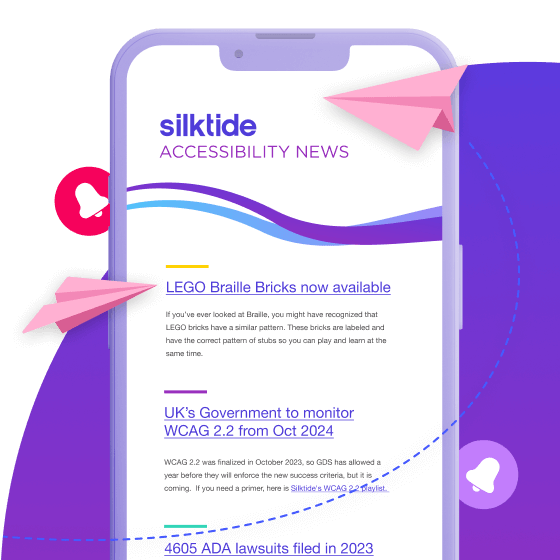Nike faces a class-action lawsuit for allegedly violating the Americans with Disabilities Act (ADA).
In our blog post covering news of the recent lawsuit against Etsy, we looked at the 250% increase of web accessibility lawsuits between 2017-2021. Following the latest guidance from the Department of Justice (DOJ) on web accessibility under the ADA, it seems like the sharp increase in cases isn’t slowing down.
If you’re unsure of the latest guidance from the DOJ, we’ve written a blog post about it, explaining things in plain English, because legal documents aren’t the most thrilling read.
So what’s the deal with Nike’s website? The core claim appears to be that Nike’s online eCommerce store is allegedly inaccessible to people with a visual impairment who rely on a screen reader to navigate the web.
Now, this includes a bunch of accessibility issues. Some can be easily identified and fixed, while others require a lot more work. So, let’s take a look at some of these accessibility issues that allegedly plague Nike’s website.
Text alternatives
The primary concern seems to be that the site allegedly fails to present text alternatives to visual elements. Visual elements like images, icons, and buttons required to navigate a site must have correct and informative alt-text or labels.
Without the correct labeling, it’s practically impossible for a visually impaired user to access your site. Here are just some of the alleged labeling issues across Nike’s website:
- Search button is mislabeled
- Shopping cart is mislabeled
- Promotional images and associated links are mislabeled
- The wide fit option is not labeled
- Size options beyond the first choice are not labeled
- Product description and details are not labeled
- In the shopping cart, the total is not labeled
The key takeaway here is to always, always, have a text alternative to any elements of your website that are required for a user to interact with. From images to forms, radio buttons, collapsable menus, anything interactive elements need to have an alternative way of being able to be understood and interacted with without relying on vision.
You can read up more on the importance of text alternatives and the success criteria under WCAG here. And if you want to better understand labels here’s another handy guide. If you want to check your own website right now, use the Silktide Accessibility Checker extension for Chrome.
You can easily test your website for this too. Using a mac you can hit CMD + F5 to switch on VoiceOver which acts just like a screenreader. On Windows, you can use screen readers like NVDA. Once you’ve activated your screenreader, go to your website and hit Tab. Keep hitting tab to navigate through your site and pick up on any problem areas. Is your site easy to understand and navigate using the keyboard?
To make things even easier, you can go ahead and download our free plugin for Google Chrome. You can use the screenreader simulator to experience how a user with visual impairments might experience your website.
Now the downside to the methods of testing above is that they take time. And if you have a large website – a lot of time. Unfortunately, that’s the nature of manual testing. However, if you want a tool that automates this and picks up on all the problem areas, then that’s where the Silktide platform comes in. I don’t mean for this to be a sales pitch, just an alternative solution.
Missing accessibility policy
Another issue that Nike’s website faces is that it allegedly doesn’t have an accessibility notice, statement, or policy where a disabled or impaired user could provide feedback and seek support. This is an easy one to fix but is so often overlooked. Make sure that you have a clear policy on accessibility with contact information.
Cookies
It’s no secret that we’re swiftly entering a world of cookie-less analytics. I could rant for a while on what a cookie-less web will look like, or the pretty nasty (and scary) stuff that some companies are doing to get around it.
Like most sites, Nike uses cookies. Cookies can track user information such as IP address, browsing history, previously visited websites, and much more. Basically, every time you click the “Accept” button on a cookie popup, you’re giving a lot of personal data away.
But that’s the point, you have to accept it. Otherwise, they are taking and saving your personal data without your consent.
The problem with Nike’s website from an accessibility point of view is that Nike allegedly adds these cookies without the user’s consent. Even with me just visiting the homepage, Nike added over 50 cookies to my browser – without telling me. Now couple this with a user who is unable to comprehend the site due to visual impairment – you have a site that has taken personal information without the user’s choice or knowledge.
You can understand why this is a problem.
But with all browsers soon to be cookie-less, is this a moot point right now? Well, no. It means that some companies are instead implementing new ways to get the same (if not more) of your personal info.
Conclusion
So, what now? Well, I’m sure Nike will be keen to fix any of the alleged accessibility issues across their site. And that’s a positive thing. But if you’re worried about falling into the same trap, what do you do about it? Here’s my advice:
- Get to know the WCAG accessibility guidelines. Get into bed with them, take them out for dinner, and really understand them. Sure they may be a bit dull, but they are necessary.
- Understand why it’s important. Is it important that you don’t get sued? Or is it because making the web accessible to everyone is simply the way the internet should be?
- Get the team on board with accessibility too. From content editors to developers and managers – help them to understand the importance of web accessibility.
- Work smart, not hard. Use automated accessibility tools where you can. Accessibility will always require manual testing in tricky areas but if you automate what you can to identify and solve most issues then you’ll save yourself a lot of headaches.
Unfortunately, there’s no silver bullet to solving web accessibility across your site. It’ll certainly take time and resources. But by knowing the what, how, and the why of web accessibility you can better integrate it into your web management processes.
If you want to see how Silktide can help with all of these things across your web estate, you can book a demo with our team.

